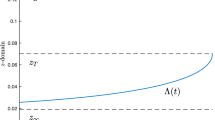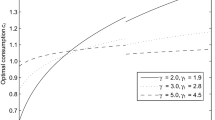Abstract
We study an optimal job-switching and consumption/investment problem of an infinitely-lived economic agent who exhibits constant relative risk aversion. We consider two kinds of jobs, one of which allows the agent to receive higher income but makes him suffer higher level of utility loss than the other. The job-switching opportunities are reversible in the sense that one can move from the current job to the other at any time. We provide the closed form solution for the optimal job-switching and consumption/investment policies by using the dynamic programming approach, and show various properties of the solution. We compare the optimal consumption/investment policies to those without job-switching opportunities. As a special case of our problem, we also compare the solution in the case where the agent has a reversible retirement option with that in the case where he has an irreversible retirement option.

Similar content being viewed by others
Notes
\(U(c)=\log {c}\) corresponds to the case where \(\gamma = 1\). We do not consider this case here, but similar results can be obtained.
References
Akerlof, G.A., Rose, A.K., Yellen, J.L., Ball, L., Hall, R.E.: Job switching and job satisfaction in the US labor market. Brookings Pap. Econ. Act. 19, 495–594 (1988)
Bodie, Z., Merton, R., Samuelson, W.: Labor supply flexibility and portfolio choice in a life cycle model. J. Econ. Dyn. Control 16, 427–449 (1992)
Boskin, M.J.: A conditional logit model of occupational choice. J. Political Econ. 82, 389–398 (1974)
Choi, K.J., Shim, G.: Disutility, optimal retirement and portfolio selection. Math. Finance 16, 443–467 (2006)
Dolton, P.J., Kidd, M.P.: Job changes, occupational mobility and human capital acquisition: an empirical analysis. Bull. Econ. Res. 50, 265–295 (1998)
Dybvig, P.H., Liu, H.: Lifetime consumption and investment: retirement and constrained borrowing. J. Econ. Theory 145, 885–907 (2010)
Farhi, E., Panageas, S.: Saving and investing for early retirement: a theoretical analysis. J. Financial Econ. 83, 87–121 (2007)
Freeman, R.B.: Job satisfaction as an economic variable. Am. Econ. Rev. 68, 135–141 (1978)
Kambourov, G., Manovskii, I.: Rising occupational and industry mobility in the United States: 1968–1997. Int. Econ. Rev. 49, 41–79 (2008)
Karatzas, I., Lehoczky, J., Sethi, S., Shreve, S.: Explicit solution of a general consumption/investment problem. Math. Oper. Res. 11, 261–294 (1986)
Longhi, S., Brynin, M.: Occupational change in Britain and Germany. Labour Econ. 17, 655–666 (2010)
Merton, R.C.: Lifetime portfolio selection under uncertainty: The continuous-time case. Rev. Econ. Stat. 51, 247–257 (1969)
Merton, R.C.: Optimum consumption and portfolio rules in a continuous-time model. J. Econ. Theory 3, 373–413 (1971)
Parrado, E., Caner, A., Wolff, E.N.: Occupational and industrial mobility in the United States. Labour Econ. 14, 435–455 (2007)
Pham, H.: Continuous-Time Stochastic Control and Optimization with Financial Applications. Springer, Berlin (2009)
Shaw, K.L.: Occupational change, employer change, and the transferability of skills. South. Econ. J. 53, 702–719 (1987)
Shim, G., Shin, Y.H.: An optimal job, consumption/leisure, and investment policy. Oper. Res. Lett. 42, 145–149 (2014)
Tang, S., Yong, J.: Finite horizon stochastic optimal switching and impulse controls with a viscosity solution approach. Stoch. Stoch. Rep. 45, 145–176 (1993)
Acknowledgments
Yong Hyun Shin gratefully acknowledges the support of Basic Science Research Program through the National Research Foundation of Korea (NRF) funded by the Ministry of Education [NRF-2013R1A1A2058027]. We are indebted to two anonymous referees for helpful comments and kind valuable suggestions to improve our paper essentially.
Author information
Authors and Affiliations
Corresponding author
Additional information
An earlier version of this paper was presented at Korean Financial Management Association 2013 Annual Meeting, Seoul, Korea, November 2, 2013, ICM 2014 Satellite Conference “Mathematical Finance and Control Theory”, Pukyong National University, Busan, Korea, August 23, 2014, and the 1st Conference on Financial and Non-Financial Risk Management, POSTECH, Pohang, Korea, January 29–30, 2015. This paper is an improved version based on that presented with the same title in the above conferences.
Rights and permissions
About this article
Cite this article
Shim, G., Koo, J.L. & Shin, Y.H. Reversible Job-Switching Opportunities and Portfolio Selection. Appl Math Optim 77, 197–228 (2018). https://doi.org/10.1007/s00245-016-9371-3
Published:
Issue Date:
DOI: https://doi.org/10.1007/s00245-016-9371-3




